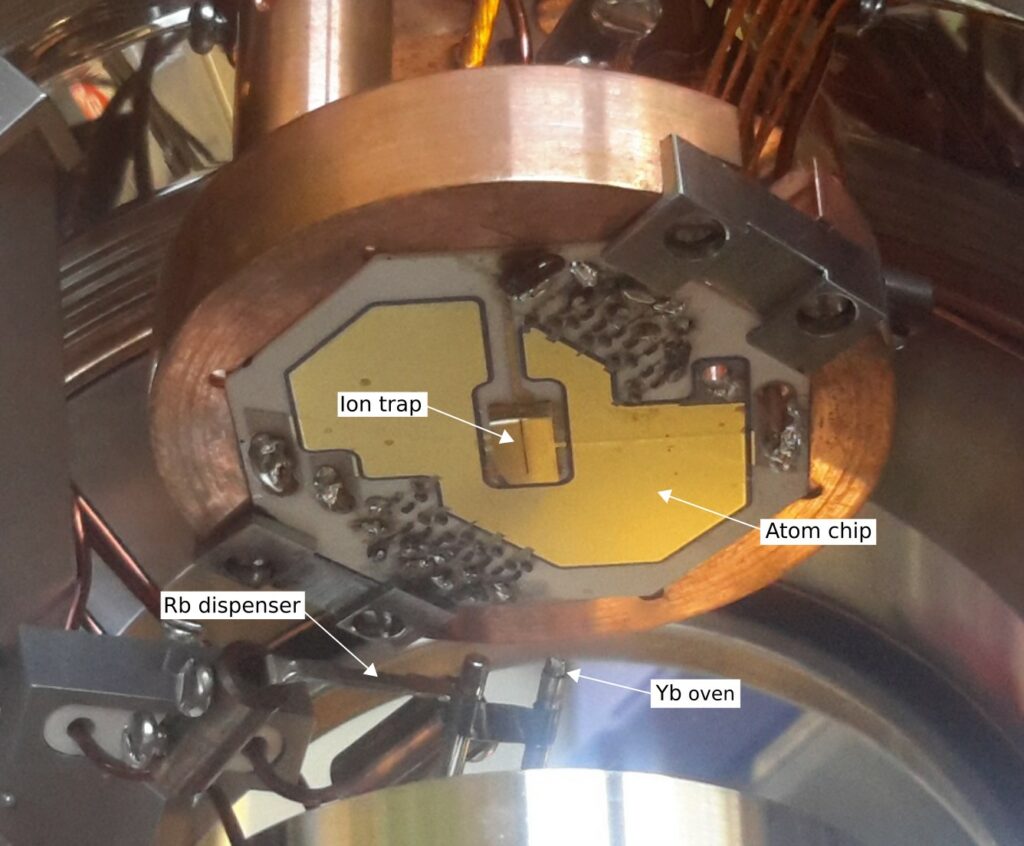Recently, the interactions between neutral atoms and charged ions have been addressed for investigations of low temperature chemical reactions [1, 2, 3], the study of polaron physics [4], but also to allow for novel types of quantum simulation [5]. From the experimental side, the challenge is to combine both trapping techniques into a hybrid atom-ion trap to study the atom-ion system. Precisely controlled ions could be used to explore the physics of impurities in (one-dimensional) Bose-Einstein condensates or to perform in-situ measurements of ultracold atomic quantum gases. Hybrid atom-ion systems are also applicable for sympathetic ground state cooling of trapped ions with ultracold atoms or vice versa. Since the long-range atom-ion interaction is much stronger than typical atom-atom interactions, single trapped ions may be used to control the dynamics of atomic systems.
In order to study interactions of atomic ions with ultracold neutral atoms, it is important to have sub-mm control over positioning ion crystals. Serving for this purpose, a microfabricated planar ion trap featuring 21 DC electrodes is introduced. The ion trap is controlled by a home-made FPGA voltage source providing independently variable voltages to each of the DC electrodes. To assure stable positioning of ion crystals with respect to trapped neutral atoms, the authors integrate into the overall design a compact mirror magneto optical chip trap (mMOT) for cooling and confining neutral 87Rb atoms. The trapped atoms will be transferred into an also integrated chip- based Ioffe-Pritchard trap potential formed by a Z-shaped wire and an external bias magnetic field. The authors introduce the hybrid atom–ion chip, the microfabricated planar ion trap, and use trapped ion crystals to determine ion lifetimes, trap frequencies, positioning ions, and the accuracy of the compensation of micromotion In order to study interactions of atomic ions with ultracold neutral atoms, it is important to have sub-µm control over positioning ion crystals. Serving for this purpose, we introduce a microfabricated planar ion trap featuring 21 DC electrodes [6]. The ion trap is controlled by a home-made FPGA voltage source providing independently variable voltages to each of the DC electrodes. To assure stable positioning of ion crystals with respect to trapped neutral atoms, we integrate into the overall design a compact mirror magneto optical chip trap (mMOT) for cooling and confining neutral 87Rb atoms. You see assembled picture of our setup in the following (Fig1).
 Fig1: Final assembly of the atom-ion chip with all wire-bonds. The atom source carrier is placed below the trap carrier and it includes a Rb atom dispenser and the Yb atom oven.
Fig1: Final assembly of the atom-ion chip with all wire-bonds. The atom source carrier is placed below the trap carrier and it includes a Rb atom dispenser and the Yb atom oven.
The trapped atoms will be transferred into an also integrated chip-based Ioffe-Pritchard trap potential formed by a Z-shaped wire and an external bias magnetic field. Hybrid trap has an outside diameter of 45 mm and a total height of 1 mm. With this design we expect trapping frequencies of > 1.0 kHz for the atoms and frequencies > 1 MHz for the linear ion crystal. Compared to common hybrid traps our combined trap design has an obvious infrastructural simplification and it provides increased trapping stability. For realizing atomic Josephson junctions this setup will enable us to form double well potentials by radio frequency induced adiabatic dressing. Due to the small size of the trap design, we realize tight confinement of the ions and atoms at about 100μm below the ion trap. This will allow us to form wave packets of the size of the atom-ion interaction range and to reach the one-dimensional regime. With this setup, we will also be able to study many-body phenomena like ion-perturbed quantum gases and ion-enabled entanglement.
 Fig2: First ions we trapped in our system. In this picture there are additionally some dark ions which are not observed as our detection laser is off for these isotopes (Left), and first MOT we trapped in a a mirror-MOT (Right).
Fig2: First ions we trapped in our system. In this picture there are additionally some dark ions which are not observed as our detection laser is off for these isotopes (Left), and first MOT we trapped in a a mirror-MOT (Right).
References
[1] F. H. J. Hall, M. Aymar, N. Bouloufa-Maafa, O. Dulieu, and S. Willitsch, Phys. Rev. Lett. 107, 243202 (2011). [2] W. G. Rellergert, S. T. Sullivan, S. Kotochigova, A. Petrov, K. Chen, S. J. Schowalter, and E. R. Hudson, Phys. Rev. Lett. 107, 243201 (2011). [3] L. Ratschbacher, C. Zipkes, C. Sias, and M. Kohl, Nat. Phys. 8, 649 (2012). [4] R. Cote, V. Kharchenko, and M. D. Lukin, Phys. Rev. Lett. 89, 093001 (2002). [5] U. Bissbort, D. Cocks, A. Negretti, Z. Idziaszek, T. Calarco, F. Schmidt-Kaler, W. Hofstetter, and R. Gerritsma, Phys. Rev. Lett. 111, 080501 (2013). [6] A. Bahrami, M. Müller, M. Drechsler, J. Joger, R. Gerritsma, F. Schmidt-Kaler, Physica Status Solidi B: Basic Solid State Physics 1800647 (2019).News
March 2020: First 87Rb mMOT
April 2019: A new publication on operation of hybrid trap in Physica Status Solidi B
August 2017: First Yb+ ions trapped ion our planar trap
June 2016: Abasalt Bahrami started his PhD